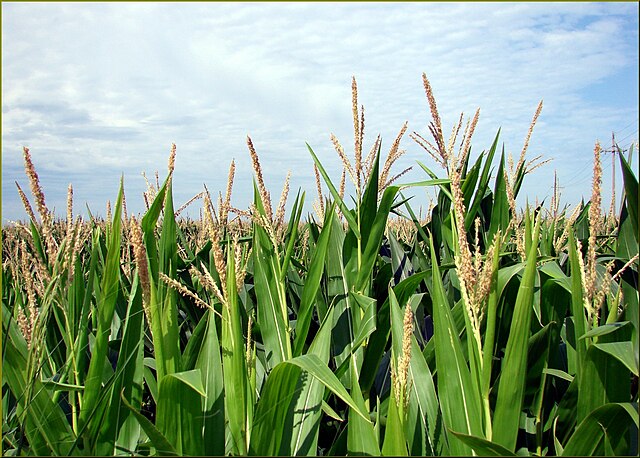American corn prices dipped before rallying on May 13, 2025, espousing mixed effects of a crop progress report indicating rapid plantings.
Early on the 13th, July deliveries shed between 4 and 6 cents at several commodity markets, to $4.14 3/4 a bushel.
Late night markets on the 13th however rebounded by 0.52%, to settle at $4.37 a bushel.
This price captures the weekly upper range, with most contracts shuffling between $4.27 and $4.49 per bushel through early May.
USDA’s Progress Report
The bearish run beforehand partially owed to the U.S. Department of Agriculture (USDA)’s latest crop progress report that reveals planting gains.
According to the Sixth Crop Progress, federal corn plantings in the 18 corn-belt states were 62% complete by May 11, 2025. This was above the five-year median of 56%.
Besides, 28% of the seed had sprouted by May 11 in all 18 states, above the 21% five-year median.
Such positive gains tend to be bearish on the markets because they indicate a future surplus while declines become bullish.
China Tariffs’ Relief
Perhaps this was why corn had underperformed on May 12 despite a Sino-American tariff brokerage that favored soybeans.
Unlike soybeans, corn did not fully absorb the news of a 90-day moratorium in tariffs between China and the U.S.
The United States temporarily cut its general tariffs on China by 115% to 30% while China slashed reciprocal levy to 20%.
American corn is therefore showing progress in the ongoing federal crop plantings without much affecting pricing. The statistics below examine how plantings on specific dates can affect yields, among other general acreage figures.
United States Corn Progress and Plantings Statistics
Farmers in the United States plant an average 90 million acres of corn on an annual basis. Most of the plantings produce ears for biofuel processing and livestock feed. 40% of the production is for domestic feed for cattle, hogs and other animals while 15% is for export. Each spring, the U.S. Department of Agriculture (USDA) carries out a crop progress survey to determine planting gains. For corn, this report mainly covers mid-April through early June.
Does corn planting timing in the U.S. affect yields?
Most plantings of corn across 18 corn-belt states begin by April 20 and end by June 9, each year. Because timing affects the overall yield, farmers rush to start early and avoid late plantings. According to the University of Minnesota, April 20 plantings yield 98 to 99% while April 29-30 ones yield 99 to 100%. The same applies for May 5 plantings, which maximize yields at 99 to 100%. The worst production is for plantings between June 4 and 9, which bring between 69 and 84% yields.
Where does American corn grow?
Regarding area, the corn belt spreads across the Midwest to almost the entire U.S. The two single-biggest production centers are Iowa and Illinois.
Is there a minimum corn planted area provision in the United States.?
In 1983, the U.S. government mandated a minimum 60.2 million acres of corn plantings per year. However, corn acreage has stayed put at over 90 million hectares per year since 2018.
What drives rising corn plantings in the United States?
The Federal Agriculture Improvement and Reform Act (1996) that gave farmers crop planting freedom helped spur corn acreage growth. Another factor is the rise of over 500-acre farms that have been replacing smaller farms.
